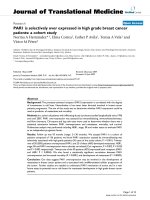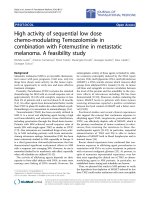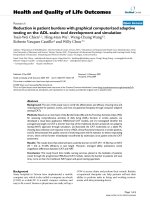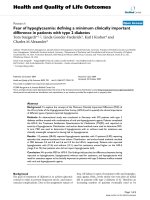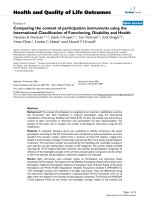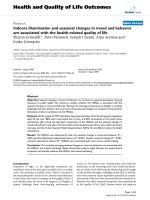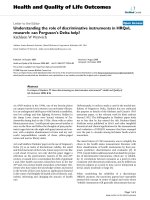báo cáo hóa học: " Gastrointestinal (GI)-Specific patient reported outcomes instruments differentiate between renal transplant patients with or without GI symptoms: results from a South American cohort" pptx
Bạn đang xem bản rút gọn của tài liệu. Xem và tải ngay bản đầy đủ của tài liệu tại đây (266.24 KB, 10 trang )
BioMed Central
Page 1 of 10
(page number not for citation purposes)
Health and Quality of Life Outcomes
Open Access
Research
Gastrointestinal (GI)-Specific patient reported outcomes
instruments differentiate between renal transplant patients with or
without GI symptoms: results from a South American cohort
Gerardo Machnicki*
1
, Jacqueline Pefaur
2
, Luis Gaite
3
, Ana M Linchenco
4
,
Clemente Raimondi
5
, Ruben Schiavelli
6
, Alcira Otero
7
and
Mary Kay Margolis
8
Address:
1
Global Health Economics and Outcomes Research, Novartis Pharmaceuticals Corp, East Hanover, NJ, USA,
2
Nephrology and Transplant,
Hospital Barros Luco, Santiago, Chile,
3
Nephrology and Transplant, Clinica de Urologia y Nefrologia, Santa Fe, Argentina,
4
Nephrology and
Transplant, Hospital Italiano, Rosario, Argentina,
5
Neprhology and Transplant, Hospital Español, La Plata, Argentina,
6
Nephrology and
Transplant, Hospital Argerich, Buenos Aires, Argentina,
7
Medical Department, Novartis Argentina, Buenos Aires, Argentina and
8
Center for Health
Outcomes Research, United BioSource Corporation, Bethesda, MD, USA
Email: Gerardo Machnicki* - ; Jacqueline Pefaur - ;
Luis Gaite - ; Ana M Linchenco - ; Clemente Raimondi - ;
Ruben Schiavelli - ; Alcira Otero - ;
Mary Kay Margolis -
* Corresponding author
Abstract
Background: Immunosuppressive therapies have burdensome side effects which may lead to sub-
therapeutic dosing and non-compliance. Patients on different immunosuppressant regimens may
feel less bothered by Gastrointestinal (GI) side effects or report better health-related quality of life
(HRQL). We evaluated the reliability and validity of two GI-specific outcome instruments
(Gastrointestinal Symptom Rating Scale (GSRS; higher scores = increased severity) and
Gastrointestinal Quality of Life Index (GIQLI; higher scores = better GI-specific HRQL)) in renal
transplant patients in South America.
Methods: Data from 5 South American centers participating in an international, longitudinal,
observational study were analyzed. Patients were ≥ 1 month post transplant and on mycophenolate
mofetil (MMF) and a calcineurin inhibitor. Patients completed the GSRS, GIQLI, and Psychological
General Well-Being (PGWB; higher scores = better HRQL) Index at baseline and at 4–6 weeks.
Internal consistency, test-retest reliability and construct and discriminant validity were assessed.
Results: Sixty-two participants were enrolled. Mean age was 42 years; mean time since transplant
was 3.3 years; 57% were male; 65% received a deceased organ transplant and 68%had GI events.
The GSRS and GIQLI demonstrated high internal consistency (Cronbach's alphas 0.72–0.96). Test-
retest reliability was adequate (intraclass correlation coefficient > 0.6) for all GIQLI subscales and
all GSRS subscales except Diarrhea and Reflux syndrome. Correlations between the GSRS and
PGWB were moderate (range: -0.21 to -0.53, all p < 0.001 except 6 correlations with p < 0.05);
correlations between the GIQLI and PGWB were higher (range: 0.36 to 0.71 p < 0.001), indicating
good construct validity. The GSRS and GIQLI demonstrated good discriminant validity, as they
clinically and statistically distinguished between patients with and without GI complaints and among
Published: 21 July 2008
Health and Quality of Life Outcomes 2008, 6:53 doi:10.1186/1477-7525-6-53
Received: 29 August 2007
Accepted: 21 July 2008
This article is available from: />© 2008 Machnicki et al; licensee BioMed Central Ltd.
This is an Open Access article distributed under the terms of the Creative Commons Attribution License ( />),
which permits unrestricted use, distribution, and reproduction in any medium, provided the original work is properly cited.
Health and Quality of Life Outcomes 2008, 6:53 />Page 2 of 10
(page number not for citation purposes)
patients with varying GI complication severity. Patients with GI complaints reported higher GSRS
scores than patients without complaints (all p < 0.001). GIQLI scores were lower in patients with
GI complaints than patients without complaints (all p < 0.001). The GSRS and GIQLI differentiated
among patients with four GI severity levels (overall Kruskall-Wallis test p < 0.001, except for one
scale). The GSRS and GIQLI are acceptable for use in South American renal transplant patients.
These two instruments demonstrate adequate reliability and validity. Patients with GI complaints
reported poor HRQL and strategies are needed to improve patients' HRQL.
Background
Graft survival in renal transplant patients has improved
steadily over the last decades as a result of improved
immunosuppressive therapies. Immunosupressive regi-
mens continue to have side effects which patients find
burdensome and which may lead to sub-therapeutic dos-
ing and non-compliance by the patient.
Specifically, upper and lower gastrointestinal (GI) side
effects such as reflux, diarrhea, and constipation are fre-
quent occurrences with these medications. While the
effects are understood on a clinical level, little is known
about the patient perspective. Some evidence suggests that
patients on different immunosuppressant regimens may
feel less bothered by GI side effects or report better health-
related quality of life (HRQL)[1]. Therefore patient
reports of these GI complications and HRQL are impor-
tant. Like any clinical measure, patient-reported outcomes
must be valid and reliable.
The Gastrointestinal Symptom Rating Scale (GSRS) and
the Gastrointestinal Quality of Life Index (GIQLI) are two
patient reported outcomes instruments with demon-
strated reliability and validity for use among renal trans-
plant populations[2,3]. However, the study population
did not include South American participants. Addition-
ally test-retest reliability was not able to be assessed in the
original study. The objective of this study was to evaluate
the psychometric characteristics (reliability and validity)
of the GSRS and GIQLI in South American patients who
have had a renal transplant.
Methods
Study population
Data from the PROGIS study, Measurement of Patient
Reported Outcomes in Renal Transplant Patients with and
without Gastrointestinal Symptoms (PROGIS)[1] were used
for this validation study. PROGIS was a longitudinal,
observational study of patients post renal transplant
designed to assess the impact of GI symptoms on symp-
tom severity and HRQL and changes in these patient-
reported outcomes (PROs) that occur as a result of conver-
sion from mycophenolate mofetil (MMF) to an enteric-
coated formulation of mycophenolate sodium (EC-MPS)
(myfortic
®
). PROGIS was conducted in twenty-seven clini-
cal sites in six countries, with a total per-protocol popula-
tion of 278 patients: 177 post-transplant patients who
were experiencing GI complaints and were eligible to con-
vert to EC-MPS and 101 post-transplant patients who
were not experiencing GI complaints remained on MMF.
Participants were evaluated at Baseline again at 4–6
weeks. Additional details and results of the PROGIS study
can be found in Chan[1]. This validation study utilized
data from five sites in Argentina and Chile only.
Research was conducted according to the ICH Harmo-
nized Tripartite Guidelines for Good Clinical Practice and
in compliance with the ethical principles of the Helsinki
Declaration. Appropriate Institutional Review Board/Eth-
ics Committee approval was obtained at each center prior
to study initiation. Patients were eligible for participation
if they were at least 18 years of age; were willing to provide
informed consent and adhere to study requirements; had
received a renal transplant at least 1 month prior to the
study enrollment; and had been on an immunosuppres-
sive regimen including MMF for at least two weeks prior
to enrollment. Patients were either eligible to convert to
EC-MPS because of GI complaints or were not experienc-
ing GI complaints and were stable on their current regi-
men. Patients were not eligible for participation if their
current GI symptoms were not assumed or known to be
caused by MMF; they had an episode of acute rejection
less than 1 week prior to study enrollment; they were
undergoing an acute medical intervention or hospitaliza-
tion; they were a woman of child-bearing age not willing
to use an effective means of birth control; they had a
major psychiatric illness or other medical condition that
might interfere with ability to complete the study; or they
had received any investigational drug within 30 days prior
to study enrollment.
Assessments
Patients who met study entry criteria and provided
informed consent were either converted to EC-MPS at
Visit 1 (Group 1) or remained on MMF (Group 2). Partic-
ipants continued on the appropriate immunosuppressant
regimen (i.e., EC-MPS or MMF plus other transplant med-
ications) as dictated by good clinical practice. Site study
staff provided basic demographic and clinical informa-
tion. Participants completed three self-administered ques-
Health and Quality of Life Outcomes 2008, 6:53 />Page 3 of 10
(page number not for citation purposes)
tionnaires in a private room at the clinic: the
Gastrointestinal Symptom Rating Scale (GSRS), the Gas-
trointestinal Quality of Life Index (GIQLI) and the Psy-
chological General Well-being Index (PGWB) at Baseline.
At Visit 2 the participants completed the same question-
naires, with the addition of the Overall Treatment Effect
(OTE) scale.
The GSRS [4-6] is a 15-item instrument designed to assess
the symptoms associated with common GI disorders. It
has 5 subscales (Reflux, Diarrhea, Constipation, Abdomi-
nal Pain, and Indigestion Syndrome). Subscale scores
range from 1 to 7 and higher scores represent more dis-
comfort. The Spanish for Argentina version of the ques-
tionnaire was utilized for this study. The minimal
important difference (MID) is the smallest difference in
the scores that is perceived as significant by the clinician
or the patient[7]. The MID range in renal transplant recip-
ients has been calculated as a range between 0.4 for
diarrhea and 0.8 for reflux[1].
The GIQLI [8] is a 36-item GI-specific HRQL instrument
designed to assess HRQL in clinical practice and clinical
trials of patients with GI disorders. The GIQLI has five
subscales (GI Symptoms, Emotion, Physical Function,
Social Function, and Medical Treatment) as well as a Total
Score. Higher scores represent better HRQL and subscores
range from 0–4 while the total score range from 0–144.
Recent MID calculations were 12.7 for the total score,
while for the subscales the range was 0.5 for Social Func-
tion to 0.2 for Emotional Status[1]. The Spanish version
of the questionnaire, with minor wording modifications
introduced by the research team based on well known dif-
ferences in medical terms between Spain and South Amer-
ica, was utilized for this study.
The PGWB [9] is a 22-item measure designed to measure
generic HRQL through assessment of psychological well-
being and distress. The PGWB has 6 subscales (Anxiety,
Depression, Positive Well-being, Self-control, General
Health, and Vitality) as well as a total score. Higher scores
represent better HRQL and the range is 0–100 for both the
subscales and the total score. The Spanish version of the
questionnaire was utilized for this study.
Additional information collected included demographic
and socioeconomic data, time since transplant, type of
transplant (deceased vs. living donor), current GI compli-
cations, severity of participant's GI complications (per cli-
nician impression), concomitant immunosuppressant
medication, concomitant medications which could lead
to GI complaints, concomitant medications to treat or
prevent GI symptoms and complications, and adverse
events/infections for each participant throughout the
study duration[1].
Statistical Analyses
All analyses were performed with SAS version 8.02 (SAS
Institute, Cary NC). Demographic variables and clinical
conditions were evaluated by descriptive analyses. For the
descriptive analyses, chi-square tests were used to evaluate
categorical data; t-tests and analyses of variance (ANOVA)
were used to evaluate continuous data. Scoring – includ-
ing imputations for missing data if necessary – was per-
formed according to each questionnaire's guidelines.
Reliability refers to the consistency of items within an
instrument, either over time or internally within the
instrument. Internal consistency reliability is the extent to
which all items measure the same construct; values are
presented descriptively, on an internal level scale from 0
to 1.0, with higher scores indicating a more reliable (pre-
cise) instrument. A Cronbach's alpha of 0.70 or greater
indicates acceptable internal consistency reliability for an
instrument used with group data[10]. The internal con-
sistency reliability of the GSRS and GIQLI total and sub-
scale scores was estimated using coefficient alpha.
Test-retest reliability, or reproducibility of the measure,
refers to the degree to which scores remain the same over
time when no change is expected [11,12]. Reproducibility
assesses whether stable participants (based on responses
on the OTE) scored similarly on the GSRS and GIQLI
from Baseline to Visit 2. Hays and colleagues[11] suggest
that intraclass correlation coefficients (ICCs) should be
greater than 0.60 in stable participants.
Validity refers to the extent to which the instrument meas-
ures the construct it purports to measure and also the
extent to which the instrument is useful for its intended
purpose[10,11,13]. Kendall's tau correlation coefficients
were used to assess construct validity. Evaluation of valid-
ity can use instruments that measure similar or dissimilar
constructs. For example a disease specific HRQL instru-
ment is often validated by using a generic instrument.
However one can also evaluate validity by using instru-
ments that measure different yet related constructs, in this
case making an assumption that correlations would be
lower. For this study, we used generic HRQL instruments
to assess validity of both the disease-specific GIQLI as well
as the GSRS, a measure of symptom impact. Construct
validity focused on the pattern and magnitude of the rela-
tionship among the GSRS and GIQLI scale scores and the
PGWB. We expected to find the following: 1) the relation-
ship between the two instruments measuring HRQL (the
GIQLI and PGWB) will be stronger, producing correla-
tions of greater magnitude than that between the GSRS
and PGWB; 2) the relationship between the PGWB total
score and the GSRS subscales will be low to moderate
(0.10 < r < 0.40); 3) the relationship between the PGWB
subscales and the GSRS subscales will be low to moderate
Health and Quality of Life Outcomes 2008, 6:53 />Page 4 of 10
(page number not for citation purposes)
(0.10 < r < 0.50) with higher correlations being found
between the GSRS Abdominal Pain and Indigestion Syn-
drome and all PGWB total and subscale scores compared
to the remaining three GSRS subscales (Diarrhea, Consti-
pation, Reflux Syndrome) 4) the relationship between the
GIQLI total score and the PGWB total score will be mod-
erate and significant and 5) the relationship between the
GIQLI Symptom subscale and the PGWB subscales will be
low to moderate (0.10 < r < 0.50) and significant[14].
Discriminant or known groups validity is the extent to
which scores from an instrument are distinguishable from
groups of subjects that differ by a key indicator, often clin-
ical in nature[15]. To evaluate known groups validity,
GSRS and GIQLI scores were analyzed by the presence or
absence of GI complications using Wilcoxon rank-sum
tests and by clinical severity (none, mild, moderate,
severe) of GI complications (as rated by the clinician)
using a Kruskall-Wallis test of overall differences and Wil-
coxon rank-sum tests for pairwise comparisons. The
expectation would be that scores on the GSRS and GIQLI
would be worse for patients with GI complaints as com-
pared to patients without GI complaints. Additionally, we
expected to see worse scores for patients with more severe
GI effects.
Results
Study Sample
Sixty-two participants were enrolled: 44 participants at
four sites in Argentina and 18 participants at one site in
Chile. Table 1 presents the demographic and clinical char-
acteristics of the participants at Baseline. Participants
were, on average, 42 years old, and had their transplant
3.3 years prior to study enrollment. Fifty seven percent of
the participants were male. Almost two-thirds of the par-
ticipants (65%) had received a deceased transplant and
had GI complaints ranging from mild to severe (68%).
Abdominal pain was the most frequently-reported com-
plaint (61%); 52% reported dyspepsia, 40% diarrhea, and
34% reported nausea. None of the differences between
participants were statistically significant, however, a
higher proportion of patients in the test-retest sample
(group 2) were male, older, with lower educational status
and had shorter time since transplant. Participants were
very similar to the participants in the entire PROGIS study
(data not shown).
Internal Consistency Reliability
The estimates of the internal consistency reliability of the
GSRS sub-scales were good (range 0.72 – 0.90) with the
exception of Abdominal Pain (Cronbach's alpha of 0.63).
The GIQLI total and subscale scores demonstrated excel-
lent internal consistency reliability (range 0.78–0.96; not
calculated for the Medical Treatment subscale because it is
a single item subscale).
Test-Retest Reliability
Twenty participants were stable from Baseline to Visit 2
(Table 2) and were used to assess the test-retest reliability
of the GSRS and GIQLI. ICCs were adequate – above the
established cut-off of 0.60 – and statistically significant (p
< 0.001) for the GIQLI total score and all subscale scores
and also for three of the five subscales of the GSRS (the
Reflux subscale had an ICC of 0.57, very close to the cutoff
point while the Diarrhea subscale was the exception with
an ICC of 0.16).
Construct Validity
Correlations between the GSRS and the PGWB ranged
from r = -0.21 (Diarrhea and Positive Well-being) to r = -
0.53 (Indigestion Syndrome and General Health) (Table
3). All GSRS-PGWB correlations were statistically signifi-
cant (p < 0.0015 or less) except for 8 correlations. Corre-
lations between the GIQLI and the PGWB were higher as
both measure similar constructs, ranging from r = 0.43
(Medical Treatment and Positive Well-being) to r = 0.71
(Emotion and Depression) (Table 3). All GIQLI-PGWB
correlations were statistically significant (p < 0.001).
Known Groups Validity
Clinical variables used to assess known groups validity
were time since transplant; presence or absence of any GI
complaint; and severity of GI complaints. Scores on the
GSRS and GIQLI were all poorly correlated with the
length of time since transplant and no difference by gen-
der was detected (data not shown). All subscales of the
GSRS and GIQLI significantly differentiated between
patients with and without GI complaints (Figures 1 and
2). The differences were also clinically significant, because
in all cases these were above the MID thresholds for each
GSRS and GIQLI subscale and total score. Severity level
analyses were conducted using four levels: none, mild,
moderate, and severe. The GSRS subscales and the GIQLI
total score and subscales were able to differentiate among
the clinical severity ratings of none, mild, moderate, and
severe (overall Kruskall-Wallis test p < 0.001 for each sub-
scale except GIQLI Social Function, Table 4). Many pair
comparisons among severity groups were statistically sig-
nificant (p < 0.0015) and also clinically significant, espe-
cially among none and other severity levels but there was
no clear consistent gradient between all severity levels.
Discussion
Psychometric evaluation is an on-going process that
incorporates quantitative as well as qualitative testing. No
single test result provides information regarding an instru-
ment's psychometric soundness; results of both reliability
and validity testing must be weighed together.
The results of this study provide evidence of both the reli-
ability and the validity of the Spanish for Argentina ver-
Health and Quality of Life Outcomes 2008, 6:53 />Page 5 of 10
(page number not for citation purposes)
sions of the GSRS and Spanish for Spain GIQLI in patients
post renal transplant in South America. These instruments
were originally developed for use in the GI area and dem-
onstrated good psychometric characteristics when used
with a wide variety of GI diseases and surgical procedures
[8,14,16]. In this study, both questionnaires demon-
strated extremely good psychometric characteristics,
including reliability and validity. Internal consistency reli-
ability of four of the five GSRS subscales was above the
0.70 cut-off for aggregate data. The GIQLI total score and
subscales for which a Cronbach's alpha could be calcu-
lated were all above 0.70 as well. Four of the five GSRS
subscales demonstrated satisfactory (above or very close
to the threshold of 0.6) reproducibility over a 4- to 6-week
period. The GSRS subscale that did not demonstrate good
reproducibility – the Diarrhea subscale – was not the same
as the subscale (Abdominal Pain) that fell below the 0.70
cut-off for internal consistency reliability, indicating that
there is no pattern of poor reliability. Nevertheless, the
low reliability score of the GSRS Diarrhea was surprising.
One potential explanation is that the test-retest popula-
tion may not have been stable in terms of diarrhea at the
time of the second measurement. In the PROGIS study,
diarrhea was the most frequent GI complaint in both
Table 1: Baseline Demographic and Clinical Characteristics
Characteristic With GI events
(N = 42)
Without GI events
(N = 20)
Total
(N = 62)
p-value
for overall
group
difference
Age (mean, SD) (41.8, 10.6) (43.4, 13.0) (42.3, 11.4) 0.617
Gender (n, % Male) (22, 52.4%) (13, 65.0%) (35, 56.5%) 0.349
Domestic status (n, % yes) 0.418
Living alone (2, 4.8%) (2, 10.0%) (4, 6.5%)
Living with a partner or spouse (35, 83.3%) (15, 75.0%) (50, 80.6%)
Other (5, 11.9%) (2, 10.0%) (7, 11.3%)
Missing (0, 0.0%) (1, 5.0%) (1, 1.6%)
Education completed (n, % yes) 0.183
Elementary/primary school (11, 26.2%) (11, 55.0%) (22, 35.5%)
Secondary/high school (18, 42.9%) (4, 20.0%) (22, 35.5%)
College degree (8, 19.0%) (4, 20.0%) (12, 19.4%)
Post-graduate degree (3, 7.1%) (1, 5.0%) (4, 6.5%)
Other (2, 4.8%) (0, 0.0%) (2, 3.2%)
Time since transplant (mean, SD, in years) (3.6, 4.4) (2.6, 2.8) (3.3, 4.0) 0.401
Type of transplant (n, % yes) 0.956
Cadaver (27, 64.3%) (13, 65.0%) (40, 64.5%)
Living donor (15, 35.7%) (7, 35.0%) (22, 35.5%)
GI complications
1
(n, % yes)
Diarrhea (25, 59.5%) (0, 0.0%) (25, 40.3%)
Dyspepsia (32, 76.2%) (0, 0.0%) (32, 51.6%)
Nausea (21, 50.0%) (0, 0.0%) (21, 33.9%)
Vomiting (6, 14.3%) (0, 0.0%) (6, 9.7%)
Abdominal pain/bloating/fullness (38, 90.5%) (0, 0.0%) (38, 61.3%)
GI bleeding
Other (22, 52.4%) (0, 0.0%) (22, 35.5%)
Pyrosis (6, 14.3%) (0, 0.0%) (6, 9.7%)
Acid reflux (4, 9.5%) (0, 0.0%) (4, 6.5%)
All others (12, 28.6%) (0, 0.0%) (12, 19.4%)
Severity of GI complaints (n, % yes)
None (0, 0.0%) (20, 100.0%) (20, 32.3%)
Mild (6, 14.3%) (0, 0.0%) (6, 9.7%)
Moderate (32, 76.2%) (0, 0.0%) (32, 51.6%)
Severe (4, 9.5%) (0, 0.0%) (4, 6.5%)
p-values were calculated using a two-sided t-test for continuous variables and using a chi-square test for categorical variables
1 Not mutually exclusive
Health and Quality of Life Outcomes 2008, 6:53 />Page 6 of 10
(page number not for citation purposes)
groups after the study started [1], however the occurrence
of diarrhea (7.4% in patients with GI events at baseline
and 7.1% in patient without GI at baseline) or any GI
event (17.7% in patients with GI at baseline and 13.3% in
patients without GI events at baseline) was low during the
study period. Therefore this new occurrence of diarrhea
may not explain the low ICC alone. However, the fluctua-
tions in diarrhea combined with a small sample size could
have explained the low ICC. To investigate this hypothe-
sis, a recalculation of this ICC in a larger, stable popula-
tion was performed by using the stable safety population
from the PROGIS study (n = 127) [1]. The ICC for
Diarrhea improved to a moderate value of 0.49 (which is
nevertheless still below the predetermined cut-off value of
0.6), while the ICC for Abdominal Pain, Indigestion Syn-
drome and Constipation remained above 0.6 and the ICC
for Reflux Syndrome reduced to 0.49. The GIQLI Total
Score and subscales all had satisfactory reproducibility. A
Table 2: Test-retest Reliability (Reproducibility): Score Stability of the GSRS and GIQLI
NMean
Test 1
Mean
Test 2
Difference Wilcoxon Rank-Sum
test
Kendall's Tau
correlation
ICC
Signed
rank
p-value
GSRS
Abdominal Pain 20 1.88 1.73 -0.15 -11.50 0.39 0.64
a
0.80
Reflux Syndrome 20 1.48 1.13 -0.35 -7.50 0.06 0.67
b
0.57
Diarrhea 20 1.37 1.63 0.27 12.00 0.25 0.49
b
0.16
Indigestion Syndrome 20 1.76 1.71 -0.05 -2.00 0.89 0.72
a
0.93
Constipation 20 1.57 1.50 -0.07 -9.00 0.19 0.73
a
0.98
GIQLI
Total Score 19 121.64 124.45 2.81 7.00 0.68 0.60
a
0.87
Symptoms 20 3.47 3.53 0.06 45.50 0.02 0.67
a
0.78
Emotion 20 3.04 3.31 0.27 11.50 0.57 0.74
a
0.81
Physical Function 20 3.08 3.15 0.07 6.50 0.64 0.53
b
0.90
Social Function 20 3.40 3.48 0.08 -0.50 1.00 0.81
a
0.82
Medical Treatment 19 3.63 3.58 -0.05 28.50 0.23 0.60
a
0.72
a
p < 0.001
b
p < 0.05
Table 3: Construct Validity: Correlations* of GSRS and GIQLI Total Scores and Subscale Scores with PGWB Total
GSRS Subscales GIQLI Subscales
Abdomin
al Pain
Reflux
Syndrome
Diarrhea Indigestion
Syndrome
Constipa
tion
Total
Score
Symptoms Emotion Physical
Function
Social
Function
Medical
Treatment
PGWB
Total
Score
-0.42
1
-0.32
1
-0.35
1
-0.49
1
-0.44
1
0.63
1
0.51
1
0.68
1
0.58
1
0.58
1
0.47
1
PGWB
Anxiety
-0.45
1
-0.33
1
-0.33
1
-0.52
1
-0.45
1
0.63
1
0.51
1
0.67
1
0.61
1
0.54
1
0.43
1
PGWB
Depressi
on
-0.37
1
-0.22 -0.29 -0.39
1
-0.37
1
0.57
1
0.44
1
0.71
1
0.51
1
0.57
1
0.49
1
PGWB
Positive
Well-
being
-0.26 -0.21 -0.30 -0.35
1
-0.30 0.49
1
0.39
1
0.57
1
0.46
1
0.52
1
0.38
1
PGWB
Self-
control
-0.34
1
-0.24 -0.24 -0.36
1
-0.40
1
0.47
1
0.43
1
0.53
1
0.40
1
0.43
1
0.36
1
PGWB
General
Health
-0.45
1
-0.31
1
-0.43
1
-0.53
1
-0.49
1
0.61
1
0.51
1
0.50
1
0.60
1
0.58
1
0.43
1
PGWB
Vitality
-0.39
1
-0.34
1
-0.37
1
-0.45
1
-0.40
1
0.59
1
0.51
1
0.56
1
0.57
1
0.57
1
0.50
1
Score and Subscales Scores
* Kendall's tau correlations
1
p < 0.001
Health and Quality of Life Outcomes 2008, 6:53 />Page 7 of 10
(page number not for citation purposes)
previous study validated the GSRS and GIQLI in renal
transplant patients[2,3]. Due to the cross-sectional study
design, test-retest reliability was not evaluated in that
research. This work adds to the validity of the GSRS and
the GIQLI not only confirming previous findings but by
also proving the stability of the scores over time.
Validity of the GSRS and GIQLI was also demonstrated in
this study. Construct validity was established through cor-
relations of the questionnaires with another, generic ques-
tionnaire, the PGWB. For the GSRS, the highest
correlations were seen between the Indigestion Syndrome
subscale and the PGWB Anxiety and General Health Sub-
scales. A high correlation was also observed between the
GSRS Indigestion Syndrome and the PGWB Total Score
and between the GSRS Constipation subscale and the
PGWB General Health subscale. The GSRS Diarrhea sub-
scale produced low correlations with the PGWB
Depressed Mood and Self-control subscales. The GSRS
Reflux Syndrome and Abdominal Pain subscales were also
poorly correlated with PGWB Positive Well-being sub-
scale. The patterns of association are also similar those
previously reported[14]. The GSRS demonstrates ade-
quate construct validity in this study.
The correlations between the GIQLI and PGWB were
higher than those between the GSRS and PGWB, as the
GIQLI and PGWB both assess a similar construct (HRQL),
whereas the GSRS assesses GI symptoms. The GIQLI Emo-
tion subscale was highly correlated with the PGWB Total
score and also with its Anxiety and Depressed Mood sub-
scales. The GIQLI Physical Function and Social Function
subscales were highly correlated with the PGWB Total
Score and PGWB General Health. The lowest correlations
were between the GIQLI Medical Treatment subscale and
the PGWB Anxiety, Positive Well-being, and Self-control
subscales. Participants received their transplants a little
over 3 years prior to enrollment in this study. Medical
treatment may not be unusually stressful for them at this
point, as they are quite familiar with the healthcare sys-
tem, their clinicians, and their treatment. Therefore, it is
logical that medical treatment would not be associated
with anxiety, positive well-being, or self-control.
The GSRS and GIQLI both demonstrated good known
groups validity, distinguishing between patients with and
without GI complaints. Also, in this South American
cohort all the results between the GI and no-GI groups
were clinically significant as the differences were above
the minimum important clinical difference calculated
using the whole PROGIS sample including the South
American participants. Both questionnaires were in some
instances able to statistically and clinically distinguish
among patients with varying GI complication severity
demonstrating sensitivity not only to the presence of
symptoms but to the severity of those symptoms as well.
However, and similar to Kleinman[2,3], clear consistent
gradient relationships were not observed.
We acknowledge the relatively small sample size of this
study. The significant differences in questionnaire scores
observed make those results even more impressive given
the small number of participants with mild and severe GI
complications. We faced some limitations in terms of the
Table 4: GSRS and GIQLI scores by physician's rating of clinical disease severity at baseline
Groups by rating of clinical severity Kruskall-Wallis
Test of overall differences
Patient reported outcome
instrument and domain
None (n = 20)
mean (SD)
Mild (n = 6)
mean (SD)
Moderate (n = 32)
mean (SD)
Severe (n = 4)
mean (SD)
Chi-Square p-value Wilcoxon
rank-sum tests
(pairwise
comparisons
with p < 0.001)
GSRS Abdominal Pain 1.33 (0.42) 2.61 (0.93) 3.29 (1.23) 3.83 (1.69) 33.75 <0.001 b
GSRS Reflux Syndrome 1.10 (0.26) 2.42 (1.32) 3.09 (1.46) 4.00 (2.12) 29.25 <0.001 b, c
GSRS Diarrhea 1.12 (0.20) 3.61 (1.69) 3.57 (1.56) 2.67 (1.70) 37.21 <0.001 a, b
GSRS Indigestion Syndrome 1.29 (0.33) 3.29 (1.81) 3.76 (1.43) 4.81 (1.68) 38.29 <0.001 a, b
GSRS Constipation 1.20 (0.38) 1.94 (0.65) 2.55 (1.26) 3.42 (2.23) 27.03 <0.001 b
GIQLI Total Score 126.00 (10.97) 95.83 (23.22) 87.02 (22.08) 65.00 (37.37) 33.25 <0.001 b
GIQLI Symptoms 3.64 (0.30) 2.65 (0.68) 2.49 (0.57) 1.87 (0.82) 35.31 <0.001 b
GIQLI Emotion 3.24 (0.64) 2.87 (0.70) 2.47 (0.74) 1.60 (0.86) 16.33 <0.001
GIQLI Physical Function 3.21 (0.61) 2.14 (0.89) 1.92 (0.91) 1.61 (1.62) 22.00 <0.001 b
GIQLI Social Function 3.55 (0.60) 3.04 (0.70) 2.74 (0.96) 2.19 (1.60) 10.22 0.017
GIQLI Medical Treatment 3.95 (0.22) 4.00 (0.00) 2.94 (1.11) 1.50 (1.91) 21.25 <0.001 b, c
Comparisons not significant unless noted.
a = none vs. mild; b = none vs. moderate; c = none vs. severe;
d = mild vs. moderate; e = mild vs. severe; f = moderate vs. severe.
Health and Quality of Life Outcomes 2008, 6:53 />Page 8 of 10
(page number not for citation purposes)
available translations of the instruments for this study. We
used the Argentinean Spanish version of the GSRS as the
most accurate available GSRS version to represent the
study population. However, one center was in Chile,
where this version may not have been an optimally cultur-
ally adjusted questionnaire. Additionally, we used the
Spanish for Spain version of the GIQLI with minimal
changes to its wording introduced by the research team
based on well known differences in medical terms
between Spain and South America. It was the impression
that the questionnaires looked acceptable to be used in
the study as a high response rate was obtained. However,
the use of country-specific versions of the GIQLI and a
Chilean-specific version of the GSRS would have been
better would these translations have been available.
Conclusion
The results of the study suggest that the Argentinean Span-
ish version of the GSRS and the Spanish version of the
GIQLI are valid and reliable for use in a post-renal trans-
plant population in South America. These results are a
useful addition to the development of patient reported
outcomes research in South America. Patients with GI
complaints reported poor HRQL and strategies are needed
to improve patients' HRQL.
List of abbreviations
EC-MPS: Enteric-coated mycophenolate sodium; GI: Gas-
trointestinal; GIQLI: Gastrointestinal Quality of Life
Index; GSRS:Gastrointestinal Symptom Rating Scale;
HRQL: Health-related quality of life; ICC: Intraclass corre-
lation coefficient; MID: Minimal Important Difference;
MMF: mycophenolate mofetil; PGWB: Psychological Gen-
eral Well-Being; PROGIS: Patient Reported Outcomes in
Renal Transplant Patients with and without Gastrointesti-
nal Symptoms.
Competing interests
Gerardo Machnicki is an employee of Novartis Pharma-
ceuticals Corporation and Alcira Otero is an employee of
Novartis Argentina SA.
GSRS Subscale Scores by Presence/Absence of GI ComplaintsFigure 1
GSRS Subscale Scores by Presence/Absence of GI Complaints.
3.25
3.08
3.49
3.79
2.55
1.33
1.10
1.12
1.29
1.20
0.00
1.00
2.00
3.00
4.00
5.00
6.00
7.00
Abdominal
Pain
Reflux
Syndrome
Diarrhea Indigestion
Syndrome
Constipation
GSRS Subscales*
Mean Score
Present (N=42) Absent (N=20)
*Higher scores indicate worse symptoms
**
**
**
**
**
**P<0.001
Health and Quality of Life Outcomes 2008, 6:53 />Page 9 of 10
(page number not for citation purposes)
Authors' contributions
JP, LG, AML, CR and RS were involved in carrying out the
study and reviewed the manuscript. GM created the
project, reviewed the study design, supervised the data
analysis and wrote the manuscript. AO created the project,
reviewed the study design and data collection and
reviewed the manuscript. MKM supervised the study
design, data collection and statistical analyses and wrote
the manuscript.
Acknowledgements
Sources of support: This study was funded by Novartis Pharma AG, Basel,
Switzerland and Novartis Argentina SA.
References
1. Chan L, Mulgaonkar S, Walker R, Arns W, Ambuhl P, Schiavelli R:
Patient-reported gastrointestinal symptom burden and
health-related quality of life following conversion from myc-
ophenolate mofetil to enteric-coated mycophenolate
sodium. Transplantation 2006, 81(9):1290-1297.
2. Kleinman L, Faull R, Walker R, Ramesh Prasad GV, Ambuehl P, Bah-
ner U: Gastrointestinal-specific patient-reported outcome
instruments differentiate between renal transplant patients
with or without GI complications. Transplant Proc 2005,
37(2):846-849.
3. Kleinman L, Kilburg A, Machnicki G, Faull R, Walker R, Prasad R,
Ambuehl P, Bahner U, Margolis MK: Using GI-specific patient out-
come measures in renal transplant patients: validation of the
GSRS and the GIQLI. Qual Life Res 2006, 15(7):1223-132.
4. Dimenas E, Glise H, Hallerback B, Hernqvist H, Svedlund J, Wiklund
I: Well-being and gastrointestinal symptoms among patients
referred to endoscopy owing to suspected duodenal ulcer.
Scand J Gastroenterol 1995, 30(11):1046-1052.
5. Dimenas E, Carlsson G, Glise H, Israelsson B, Wiklund I: Relevance
of norm values as part of the documentation of quality of life
instruments for use in upper gastrointestinal disease. Scand J
Gastroenterol Suppl 1996, 221:8-13.
6. Kulich KR, Pique JM, Vegazo O, Jimenez J, Zapardiel J, Carlsson J,
Wiklund I: [Psychometric validation of translation to Spanish
of the gastrointestinal symptoms rating scale (GSRS) and
quality of life in reflux and dyspepsia (QOLRAD) in patients
with gastroesophageal reflux disease]. Rev Clin Esp 2005,
205(12):588-594.
7. Guyatt GH, Osoba D, Wu AW, Wyrwich KW, Norman GR: Meth-
ods to explain the clinical significance of health status meas-
ures. Mayo Clin Proc 2002, 77(4):371-383.
8. Eypasch E, Williams JI, Wood-Dauphinee S, Ure BM, Schmulling C,
Neugebauer E, Troidl H: Gastrointestinal Quality of Life Index:
development, validation and application of a new instru-
ment. Br J Surg 1995, 82(2):216-222.
9. Dupuy H: The Psychological General Well-Being (PGWB)
Index. In Asessment of quality of life in clinical trials of cardiovascular
GIQLI Subscale Scores by Presence/Absence of GI complaints ***Figure 2
GIQLI Subscale Scores by Presence/Absence of GI complaints ***.
2.45
2.44
1.92
2.73
2.95
3.64
3.24
3.21
3.55
3.95
0.00
0.50
1.00
1.50
2.00
2.50
3.00
3.50
4.00
Symptoms Emotion Physical Function Social Function Medical Treatment
GIQLI Subscales*
Mean Scor e
Present (N=42) Absent (N=20)
*Higher scores indicate worse symptoms
**
**
**
***
**
**p< 0.0 01 *** p =0.002
* Total score results not shown because of the scale.
Total score: GI Present: 86.18, GI Absent: 126 **
Publish with BioMed Central and every
scientist can read your work free of charge
"BioMed Central will be the most significant development for
disseminating the results of biomedical research in our lifetime."
Sir Paul Nurse, Cancer Research UK
Your research papers will be:
available free of charge to the entire biomedical community
peer reviewed and published immediately upon acceptance
cited in PubMed and archived on PubMed Central
yours — you keep the copyright
Submit your manuscript here:
/>BioMedcentral
Health and Quality of Life Outcomes 2008, 6:53 />Page 10 of 10
(page number not for citation purposes)
therapies Edited by: Wenger NK, Mattson ME, Furberg CD, Elinson J.
Washington, DC , Le Jacq Publishing; 1984:170-183.
10. Nunnaly JC, Bernstein IH: Psychometric Theory. 3rd. edition.
New York , McGraw-Hill, Inc.; 1994.
11. Hays R, Anderson R, Revicki DA: Assessing reliability and validity
of measurement in clinical trials. In Quality of life assessment in
clinical trials Edited by: Staquet MJ, Hays RD, Fayers P. New York ,
Oxford University Press; 1998.
12. Leidy NK, Revicki DA, Geneste B: Recommendations for evalu-
ating the validity of quality of life claims for labeling and pro-
motion. Value Health 1999, 2(2):113-127.
13. Fayers P, Machin D: Quality of life: Assessment, Interpretation
and analysis. New York , John Wiley & Sons, Ltd.; 2000.
14. Revicki DA, Wood M, Wiklund I, Crawley J: Reliability and validity
of the Gastrointestinal Symptom Rating Scale in patients
with gastroesophageal reflux disease. Qual Life Res 1998,
7(1):75-83.
15. Jenney ME, Campbell S: Measuring quality of life. Arch Dis Child
1997, 77(4):347-350.
16. Talley NJ, Fullerton S, Junghard O, Wiklund I: Quality of life in
patients with endoscopy-negative heartburn: reliability and
sensitivity of disease-specific instruments. Am J Gastroenterol
2001, 96(7):1998-2004.
